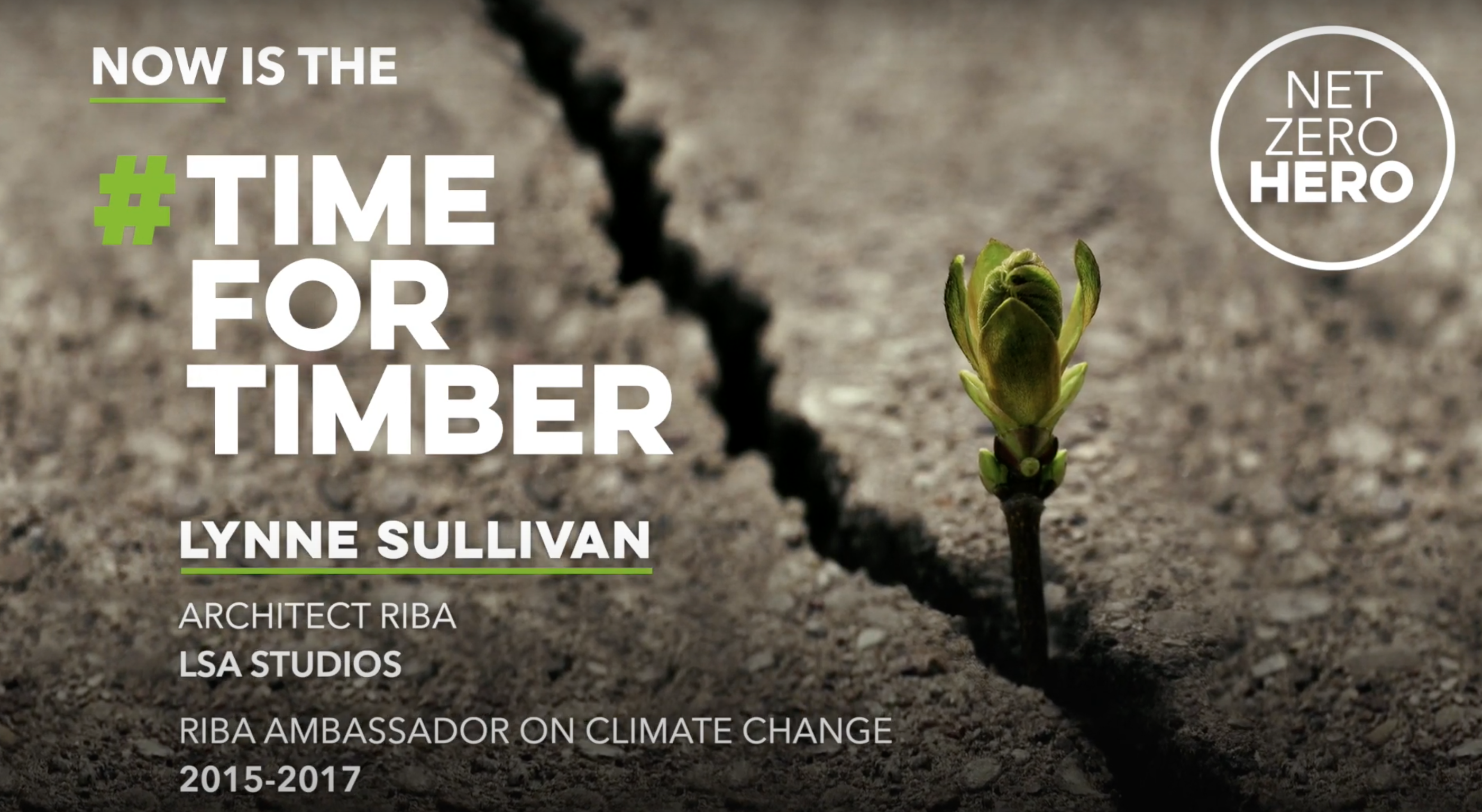Lynne Sullivan is an architect at LSA Studios and formerly a RIBA climate ambassador on climate change.
Here is her thinking as to why now is the time for timber.
What are your thoughts on the Government’s ambition to get to Net Zero by 2050?
I’m a great supporter of the net zero carbon objective. I’ve been working with the Green Construction Board on pathways to net zero for construction. We need to move towards much better energy efficiency in buildings and we need to measure what happens when things are built. This is something we don’t do at the moment. That’s the way that we can work towards net zero, to really understand how much energy we use in buildings and understand the potential for reducing it.
What do you see as the fundamental change that is needed in design for net zero homes?
I think we have to bring consumers on board. I think we need to enable them to make the connection between good quality construction and their own carbon footprint and the future carbon footprint of the nation and the net zero objective. I think the consumer journey is key. I think quality is too. At the moment we’ve got a huge performance gap between what we’re supposed to be delivering in design and what is actually delivered on site. I think quality needs to improve across the board, but a lot of people have already got there and I think we just need to embed it in legislation to really show the way. Government should show leadership in this area too.
What leadership is there at the moment?
I think that the overall objective of net zero is laudable and we are one of the leaders in the world to clearly declare net zero for 2050, but I think actually getting there, the pace of change has to really ramp up and there needs to be real clarity on what the market is obliged to achieve in order to get there.
What is Sustainable by Design doing to meet today’s challenges?
In my work as a competitions and design advisor, I’m a consultant to planning authorities and I’m a consultant to the RIBA. In both, the context of planning, looking to the future, when you think we’re looking at schemes that will be built out post-2030, I think it is really important to make sure that, especially in councils where they’ve declared a climate emergency, that we point the way towards the right type of design and the right aims for performance of those buildings.
Are there any good examples?
I think there are some really good examples. I’m working with Cambridge and the combined authority with Peterborough. They have just set up a Climate Commission which is going to look at sustainability in that whole area, East Anglia in the round, looking at emissions from buildings and how to reduce them. This includes existing buildings as well as agriculture and transport, which are obviously key parts of the equation if you’re really wanting to drive towards net zero.
Are you experiencing any resistance from stakeholders such as insurers and lenders when clients ask for low carbon buildings?
I think there needs to be more encouragement. I think we need to bring consumers along with this journey. It is very interesting to see that all the big investors in the City, Mark Carney et al, have been very clear about future climate resilience being an absolutely key part of investor assurance. I think to be able to prove that your buildings are going to work, and are resilient in the future, is a real draw and potentially what investors will commit to, from now. I think the only resistance has been the issue about timber, particularly in the context of fire resistance, but I think the industry does know how to deal with that and I think, certainly for low rise housing, there is absolutely no reason why we shouldn’t be promoting that. It is sustainable and, given the right chain of custody and an understanding of where that timber is coming from, is just an obvious thing to do – it is not a high embodied energy material.
What role does timber have in the design of buildings in the future?
People really want to make a contribution to resisting the destruction of our planet and I think one of the ways that they can do that is to be enthusiastic about the use of timber in building. We just have to be very clear about its performance values, fire being a key one, but we can do that, and timber has a huge part to play in sustainability. I think the use of timber in buildings can only increase, especially as we are now thinking very seriously about our own resilience, as the UK, and the potential for using more of our home-grown product.
Tell us about the Home of 2030 competition and your involvement?
I’ve been acting as the design advisor to the government for the Home of 2030 competition, for which the shortlist was recently announced by the Housing Minister. We had hundreds of entries. We worked with several government departments to develop the brief. One of the aspects was obviously climate resilience, looking at net zero readiness. We also looked at flexibility and design for an ageing population, looking at the aspects of health and wellbeing. What was remarkable was how many of the entries were using timber-based products, or structural timber. That was a fascinating example of how timber is now really the default option for low rise housing.
Do you think that the construction supply chain is ready for Net Zero and their understanding of embodied carbon?
I chair the Good Homes Alliance and quite a few of our members are leading product manufacturers who have aligned themselves to the net zero agenda. Quite a lot of them are also based in other countries, Europe and beyond. In many ways they are seeing a certain reticence in this country to employ their products at mass scale, which makes me think that, with the road to net zero, we need to develop more in terms of the supply chain. We need to work with the supply chain, to do more in this country. We know what we need to do – other people are already doing it and I think there is great potential, economically, for developing the products we need for the homes of the future.
I was 10 years on the Building Regulations Advisory Committee, and I remember my first meeting. I asked how we were measuring embodied energy in buildings? Nothing has changed. We’re still not measuring embodied energy in buildings and yet the government is talking about the circular economy and moves to look at whole life carbon and, of course, embodied energy is an absolutely key component of whole life carbon. To do that we need to start counting it and understanding the whole life implications. We have quite a long way to go in terms of our ability to properly measure embodied carbon across the lifetime of a building.
How confident are you for the future use of timber in construction?
I’m absolutely confident because I’ve seen buildings across Europe which use timber and are meeting the sort of performance levels that we are looking for, for our net zero journey. I’m absolutely confident that timber is part of that journey. We just need to be doing more of it in this country and sooner.




